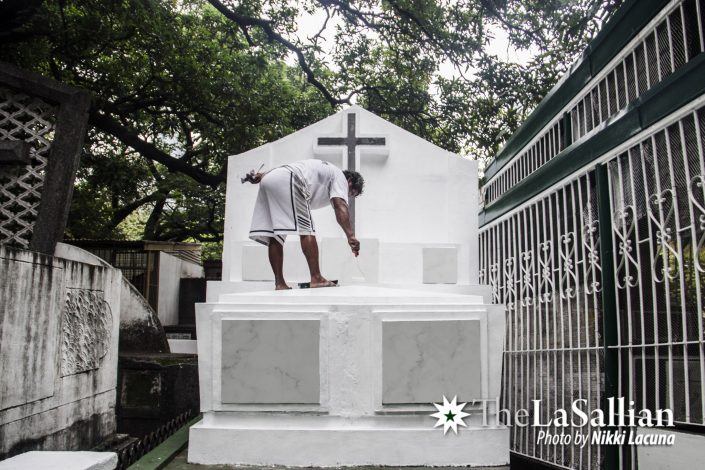With just a spade, a pickaxe, and some rivets, a 2.5-meter deep hole is dug into the ground. The danger of getting cut by a rusty nail or broken glass is palpable. On rainy days, incredibly high, too, is the risk of battling cave-ins caused by waterlogged ground. Once the grave is dug, the casket is carried. Careful—it must neither be hit nor moved once laid in its grave. At last, shovelfuls of soil are tossed into the grave as a family watches on, their loved one returning to the earth. This is the reality of the gravedigger.
A grave situation
About 280 informal gravediggers reside in the grassy, grave-dotted Manila South Cemetery. Among them is 48-year-old Renato Maranan. Having lived in the cemetery for the past three decades, Renato was only a teenager when he followed in his uncle’s footsteps, coming all the way from Quezon province to work as a public cemetery caretaker. “Nalaman [kong] dito siya (tiyuhin ko) nakatira sa sementeryo. Naglakas-loob na mag-istow away ako noong panahon na ‘yon—binatilyo ako—dito ako pumunta,” he shares.
(I found out that [my uncle] lived here. I mustered the courage to leave [the province] at that time—I was a teenager—and I came here.)
Renato, along with his fellow caretakers, have long had a job that only a few are brave enough to take on. Once in a while, he has to dig up graves and open coffins to remove the remains of those who have long passed. The reasons vary; sometimes, relatives would like to have a reburial elsewhere. There are other times where a family will bury another loved one in the same grave due to financial reasons.
Reopening tombs is the most difficult part of the job, as Renato and his fellow caretakers go gloveless when handling the remains, regardless of the potential harm,“[Mga injury dahil sa] pako, basag na salamin—naranasan na ho namin ‘yan.”
(Injuries due to nails, broken glass—we’ve experienced those already.)
He further shares, “‘Yung pinakamahirap ay ‘yung nagbubukas kami ng nitso, mga more than 10 years na siya, pero medyo buo ‘yung body niya. No choice kami kung hindi siya tanggalin dahil gusto ng pamilya o dahil may ililibing [kaming] iba.”
(The hardest part is when we open the tombs, and the corpse is more than 10 years old, but the body is sometimes still quite intact. We have no choice but to remove them, either because the family wants to relocate them or because we need to bury someone else there.)
Spooky season
With the Halloween and All Souls’ Day atmosphere still perceptible, Renato is reminded of several supernatural encounters he’s had, recounting, “Bukod sa paglilibing, bukod sa pagiging sepulturero, ‘yung mga sinasabi nilang nagpapakita, mga nagpaparamdam dati. Noong araw, meron talaga ganun. Mayroon [talagang] ganun…Diyan lang talaga, mayroon. ‘Yung mga maliliit na tao.”
(Aside from burying the dead, aside from being cemetery caretakers, there have been experiences with other beings showing themselves to us and making their presence known. Back in the day, there really were beings in this area. There were even dwarves.)
Ghost stories aside, Renato looks forward to the months of October and November—for cemetery caretakers, this time period represents their season of giving and receiving. “‘Yung Halloween sa kanila, pagdalaw sa mga mahal nila sa buhay na namayapa; kami naman, eto naman ‘yung masaya kami dahil binibigyan nila kami ng pera para sa susunod na Christmas, ‘yun po ang pangbibili namin ng panghanda,” Renato explains, adding that he is able to earn more than his monthly income through receiving tips.

(For them, Halloween means visiting their loved ones who have passed away; for us [caretakers] we’re happy because we receive money from them. We set this aside for Christmas so that we can use the money to buy food and other things for the occasion.)
With crowds of mourners paying visits to their dearly departed, more and more people approach Renato to ask him to clean and maintain their loved ones’ tombs and mausoleums—a way of honoring their dead loved ones.
Final farewell
Even with the shadow of death constantly surrounding him, Renato has never become numb to the great pain that comes with losing a loved one. Before he seals a tomb or covers a grave, he lets families go through their last viewing. By giving the living and the dead a chance to connect for one final time, he helps the bereaved come to terms with the grief.
These small touches of human sympathy are the nuances of being a gravedigger. As Renato conveys, “Siyempre, kasama na [sa amin] ‘yung pakikidalamhati at ‘yung lumuha. ‘Yung manahimik.”
(Of course, it is part of our role to mourn with the families, to cry, to know when to be silent.)
A gravedigger is burdened with the colossal weight of separating life from death, of burying the last memories of a loved one. But it is exactly this role as the final executor that lends a quiet dignity to the job. “Kung titignan ang trabaho ng isang sepulturero, [napakarangal] po, kahit wala sa estado [ng] gobyerno, wala [sa] listahan ng mga matataas na trabaho,” Renato affirms.
(If you consider the job of a gravedigger, it is very honorable work, even though it’s not thought to be at the same level as government positions, nor is it often listed as a high-ranking job.)
Looking at the silent landscape of the graveyard, Renato smiles and shares, “Halos lahat dito, proud kami sa trabaho namin. Hindi kami ‘yung taong sumusukat ng kung sino ka, kung may pera ka. Basta po kapag kailangan niyo ng sepulturero, nandito lang po kami.”
(Almost everyone here is proud of their work. We’re not the type of people to judge anyone for who they are or for their social class. Just know that if ever you are in need of someone to look after a grave, we are right here.)
